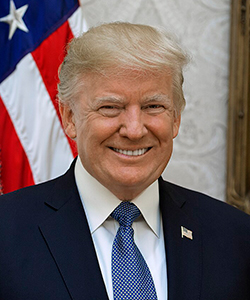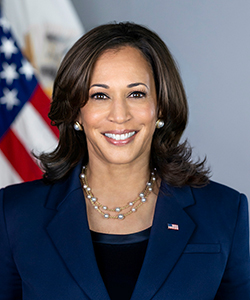The outcome of the US presidential election could have major implications for healthcare in America for decades to come. Bette Browne reports

Mr Donald Trump

Vice-President Kamala Harris
In her race against Mr Donald Trump for the White House, Democratic Vice-President Kamala Harris frequently highlights healthcare as a central issue.
So if she wins the presidential election and follows through on her pledges, the US healthcare system could see profound changes, including expanding access to health insurance, childcare, family leave, and abortion rights, as well as lower drug costs.
At their first presidential debate on 10 September, the two candidates sparred over their positions on healthcare and the contrasts between their policies were starkly evident. Mr Trump’s stances tend to be better known as he has been eyeing a run for the office since he lost his re-election bid in 2020 to President Joe Biden.
The former President has talked for years, for example, about reversing the Affordable Care Act, which was introduced by Democratic President Barack Obama over 14 years ago to make health insurance more affordable for millions of Americans. But polls show Americans now like the insurance plan and a number of legal and political attempts by Republicans to reverse it have failed. Still, this has not deterred Mr Trump from launching attacks on the plan, though he has not provided any specific plan of his own.
Indeed, the topic of healthcare was a damaging moment for Mr Trump in the debate. When questioned by a moderator about his failure to produce a health plan, he responded: “We are working on things. We’re going to do it. We’re going to replace it.” However, he admitted that he did not currently have a plan. “So, just a yes or no, you still do not have a plan?” the moderator asked again. “I have concepts of a plan,” Mr Trump replied.
Abortion
Abortion restriction is another area favoured by Mr Trump. When he was President from 2017 to 2021, he appointed three conservative justices to the US Supreme Court and has credited his move with the overturning by the Court in June 2022 of the Constitutional right to abortion. “I delivered everything as promised, including nominating and getting three highly respected and strong constitutionalists confirmed to the United States Supreme Court,” he said in a statement after the court decision. “It was my great honour to do so.” However, not long after the ruling, medical concerns among Americans about the ruling began to be reflected in polls. They indicated that a majority opposed abortion bans without exceptions.
By the time the Republican party held its convention in July this year to confirm Mr Trump as its candidate in the November election, it had stripped from the platform its decades-old call for federal limits on abortion. Instead, the party said it supported state-level elections on abortion policy and opposed what it called “late-term abortion”. It should be noted, however, that only about 1 per cent of abortions in the US occur after 21 weeks of pregnancy, according to the Kaiser Family Foundation healthcare policy research group.
As Democrats challenged him on the issue of reproductive rights, the former President softened his position on abortion, before later reversing course. On 29 August, he criticised a six-week abortion ban in Florida by the Republican Governor Ron DeSantis. He also said he supported having the government or insurance companies cover in vitro fertilisation (IVF) treatments.
IVF
IVF became a major campaign issue in February when the Alabama Supreme Court declared frozen embryos to be children under state law in wrongful death lawsuits. This sparked concerns that medical professionals could be criminally prosecuted for embryos lost during IVF. But Mr Trump’s stance was at odds with many in his party who had voted against a congressional bill in June to expand access to IVF and other fertility treatments, with many saying that fertilised embryos should be considered the same as children.
Mr Trump’s changed position was also met with scepticism by Democrats. Massachusetts’ Democratic Governor Maura Healey stated that voters could not “believe anything” he said on reproductive issues or his proposal to have the government or insurance companies cover IVF.
But more worrying for Mr Trump, perhaps, was the Republican backlash. On 30 August, within 24 hours of indicating his support for the amendment to Florida’s constitution that would enshrine the right to abortion, he changed his stance and pledged to vote against it. In an interview with Fox News that day, Mr Trump said he still disagreed with a six-week ban, but that he would vote against the amendment because he opposed what he called “radical” access to the procedure that he said was favoured by Democrats.
Vice-President Harris immediately pounced on his remarks, declaring in a written statement: “Trump just made his position on abortion very clear: He will vote to uphold an abortion ban so extreme it applies before many women even know they are pregnant.”
When both candidates sparred over the issue in their 10 September debate, the former President refused to say if he would veto a national abortion ban if he were re-elected to the White House. Vice-President Harris attacked him for the current patchwork of abortion laws across the country. Abortion is banned or restricted in nearly two dozen states and she referred to the laws repeatedly as “Trump abortion bans”.
“The government, and Donald Trump certainly, should not be telling a woman what to do with her body,” she declared. “Pregnant women who want to carry a pregnancy to term, suffering from a miscarriage, being denied care in an emergency room because their healthcare providers are afraid they might go to jail, and she’s bleeding out in a car in the parking lot – she didn’t want that. Her husband didn’t want that.” She added that if she were elected President and if Congress passed a bill to codify Roe vs Wade, guaranteeing a federal right to abortion, she would sign it.
Conservative organisations that support Mr Trump, such as the Heritage Foundation think tank, suggested that, if elected in November, he should pursue abortion restrictions through executive order, which would not require the support of Congress. The Heritage Foundation’s 2025 Presidential Transition Project, known as ‘Project 2025’, has been drafting executive orders to roll back Biden-Harris era policies that have been expanding abortion access, according to a January 29 report by Politico.
Recently, Mr Trump has sought to distance himself from Project 2025, disavowing any connection to both its drafting and the policies it proposes. The project is a blueprint for what a second Trump administration would look like, vastly expanding presidential powers and imposing an ultra-conservative social agenda. It would place the entire federal bureaucracy, including independent agencies like the Department of Justice, under direct presidential control. Democrats have rejected the former President’s claims of disassociation from the project, noting that many of its contributors worked in Mr Trump’s first administration. Some are expected to join a second if he is elected in November.
Wider policies
Another major issue for Mr Trump is his opposition to tightening gun laws. During his term in the White House, he tried several times to loosen gun-control restrictions, even as gun violence became the leading cause of death among children and adolescents in 2020. The scale of the violence prompted US Surgeon General Vivek Murthy to declare the issue a public health crisis.
Vice-President’s Harris’ policies, on the other hand, have only begun emerging more clearly since she was endorsed as the Democratic candidate. The endorsement occurred in a dramatic twist to the election in July when, after a disastrous debate performance against Mr Trump, President Biden withdrew from the race and backed her candidacy. Then, after the shortest campaign in a US presidential election, she was formally nominated on 22 August as the Democratic candidate in the race against Mr Trump.
Harris nomination
Her nomination was a dramatic turn of events, not just for the 59-year-old Democratic Vice-President, but also for 78-year-old Mr Trump. It effectively upended his carefully crafted campaign to portray President Biden, who is almost 82, as lacking the physical and mental capacity to lead America for four more years.
Now, however, Mr Trump is facing generational change with Vice-President Harris as his opponent. For her part, she has moved swiftly to focus the campaign on key issues for younger voters, like childcare, parental leave, and reproductive rights, which she stresses would include continued access to contraception and fertility treatments. On 16 August, she also pledged to erase billions of dollars in medical debt and help people to avoid accumulating such debt in the future “because no one should go bankrupt just because they had the misfortune of becoming sick or hurt”.
Indeed, medical debt is a personal issue for her running mate, Minnesota Governor Tim Walz. His father died of cancer when Mr Walz was 19, leaving his mother drowning in debt, he recalled. Earlier this year, an analysis by the Kaiser Family Foundation health research group of government data estimated that Americans owe at least $220 billion in medical debt.
But it has not been all plain sailing for Vice-President Harris. She is facing questions, for example, on why she no longer supports extending the government’s Medicare insurance programme for the elderly to cover all Americans, effectively ending private health insurance.
During a debate in 2019, when she last ran for the presidency, Vice-President Harris raised her hand when moderators asked candidates if they would get rid of private health insurance. But she quickly changed that to say she would not work to eliminate private health insurance. Earlier the same year, she had co-sponsored with Senator Bernie Sanders a ‘Medicare-for-all’ bill, which would have ended private health insurance and replaced it with a single government-run insurer, like Medicare.
The Harris campaign has effectively characterised her changed stance as pragmatic politics. “It is that [pragmatic] approach that made it possible for the Biden-Harris administration to achieve bipartisan breakthroughs on everything from infrastructure to gun violence prevention,” campaign spokesperson Ms Mia Ehrenberg told CBS on 15 August.
“It’s not a one-size-fits-all solution. I think she understands that Americans want to have their choice of healthcare, but we can do better and save people money on healthcare,” said the Vice-President’s supporter Colorado Governor Jared Polis on ABC on 1 September.
Vice-President Harris casts healthcare as a basic right for all Americans, something that should be accessible with the help of comprehensive and affordable insurance cover. “Access to healthcare should not be a privilege, it should be a right,” she declared in an NBC interview on 19 August, just days before becoming her party’s presidential candidate.
The government, and Donald Trump certainly, should not be telling
a woman what to do with her body
“In America today one of the leading causes of bankruptcy for families is the inability to pay a hospital bill. We need to reform our healthcare to ensure access. We have a situation where pharmaceutical companies have been dictating the process in a way that is pricing people out of their ability to buy insulin. It’s so darn expensive that you have people sitting down and deciding whether they should pay their rent or pay for all the insulin they need.”
Her remarks followed a joint announcement with President Biden at a rally on 15 August that elderly Americans would be able to save thousands of dollars on drug prices under an agreement by the White House. The administration’s Inflation Reduction Act negotiated down the prices of 10 top-selling prescription drugs used by the Medicare insurance plan for seniors by as much as 79 per cent. The Act, signed into law in 2022, was the first to allow Medicare to negotiate prices for some of the most costly drugs that the programme covers for 66 million Americans.
When the $2,000 (€1,800) out-of-pocket cap on prescription drugs applies in 2025, nearly 19 million seniors and other beneficiaries are projected to save $400 (€360) per year on prescription drugs. A total of 1.9 million enrollees with the highest drug costs would save an average of $2,500 (€2,250) per year. The agreement would reduce the price of 10 key medicines for conditions including diabetes, heart failure, and blood clots, according to a 15 August White House statement.
The cost of healthcare has always been a major issue for Americans. They face the highest prescription drug prices in the world, leaving many to pay partly out of their own pocket, despite what are already very expensive insurance premiums. “We finally beat big pharma,” President Biden declared at the August rally, highlighting the fact that Vice-President Harris’ tie-breaking Senate vote ensured passage of the law, which no Republicans had supported. “My entire career, I have worked to hold bad actors accountable and lower the cost of prescription drugs,” Vice-President Harris said. “Medicare can use that [collective bargaining] power to go toe-to-toe with big pharma and negotiate lower drug prices.”
In response, Republican party leaders, including House of Representatives Speaker Mike Johnson, described the deal as “price fixing”. “Their prescription drug price fixing scheme has accomplished just two things: Driving up healthcare costs and crushing American innovation in medicine,” he said.
Before Vice-President Harris entered the race, healthcare issues seemed far from Mr Trump’s radar and were not discussed in any great detail at the Republican National Convention in July when he accepted his party’s nomination. Of the 20 pledges on the party’s platform, only one was directly healthcare-related. It vowed to “fight for and protect social security and Medicare with no cuts, including no changes to the retirement age”. High costs were also referenced.
“Healthcare and prescription drug costs are out of control. Republicans will increase transparency, promote choice and competition, and expand access to new affordable healthcare and prescription drug options. We will protect Medicare and ensure seniors receive the care they need without being burdened by excessive costs.”
In his speech accepting his party’s nomination on 18 July, Mr Trump again made general promises to protect the Medicare health insurance programme and find cures for Alzheimer’s disease and cancer. However, he did not present any concrete healthcare plans for a potential second term.
One speaker at the Republican convention, Congresswoman Marjorie Taylor Greene, said that people crossing the Mexican border had caused a surge of drug overdoses and deaths. But the facts suggest otherwise. According to the Cato think tank, most fentanyl seized at the border with Mexico enters through legal ports of entry, and most people sentenced in the US for fentanyl trafficking are American citizens.
Vice-President Harris was sceptical of Mr Trump’s promises not to cut Medicare for the elderly or Medicaid for the poor when she spoke to thousands of supporters at the Democratic Convention on 22 August, which nominated her as its candidate. “We are not going back to when Donald Trump tried to cut social security and Medicare. We are not going back to when he tried to get rid of the Affordable Care Act [or] when insurance companies could deny people with pre-existing conditions,” she declared.
She said that Donald Trump had hand-picked members of the Supreme Court to take away “reproductive freedom” and she pledged, if elected, to work with Congress on a bill to restore reproductive rights. In the two years since Roe vs Wade was overturned, she told delegates, couples had shared their stories with her. “Stories of women miscarrying in a parking lot…. Getting sepsis…. Losing the ability to ever have children again…. All because doctors are afraid of going to jail for caring for their patients. Couples just trying to grow their family… cut off in the middle of IVF treatments. Children who have survived sexual assault, potentially forced to carry the pregnancy to term. This is what is happening in our country.”
On the campaign trail, Vice-President Harris frequently says she wants to build a country “where healthcare is a human right”. But whatever about healthcare being seen as a “human right”, spending on healthcare in America is certainly a major priority for the government and is forecasted to exceed $5 trillion next year. So how each candidate will shape US healthcare remains a top issue for voters.
Indeed, polling by the Kaiser Family Foundation has found that voters view healthcare as one of their top economic concerns. People say they worry more about paying for healthcare than paying for petrol for their cars or for their rent or their mortgage and in some polls, according to the foundation, healthcare costs barely trail inflation as a concern. Meanwhile, as the November election moves ever closer, Vice-President Harris is shown to be tying with Mr Trump in a number of polls.
With the race this tight, it’s still all to play for.













Leave a Reply
You must be logged in to post a comment.